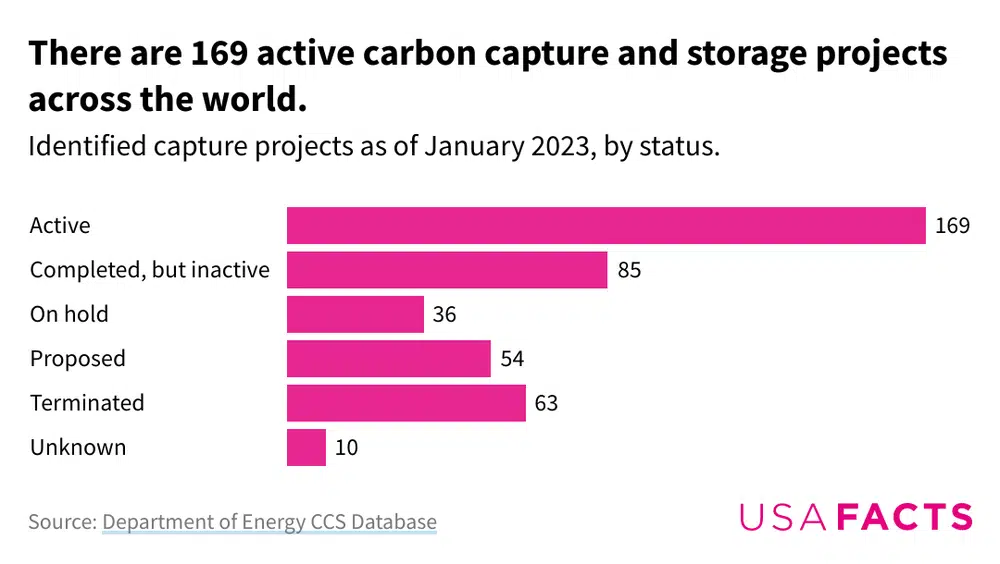From electric vehicle charging stations to renewable energy, the US is increasingly turning to new technology to mitigate the impacts of the climate crisis.
One emerging technology is carbon capture and storage, and some of the $369 billion in climate and clean energy incentives in 2022’s Inflation Reduction Act includes funds for such projects. While the carbon capture industry is still emerging, it is set up to play an important role in achieving net zero emissions in the coming decades.
How does carbon capture work?
Carbon capture and storage is a process that captures carbon dioxide emissions, compresses, transports, and stores it deep underground. The carbon capture occurs either at carbon-emitting sources such as coal-fired power plants, known as point source capture, or directly from the atmosphere, known as direct air capture. It is then transferred to large-scale storage facilities and stored in formations such as natural saline reservoirs, depleted oil/gas fields, or other stable formations with high capacities.
Carbon capture traps carbon dioxide that’s already been generated. This differs from renewable energy, which produces energy with fewer emissions, and carbon offsets, which permit purchasers to create some emissions in exchange for a fee to fund greenhouse gas reduction.
How many carbon capture projects are active? Where are they located?
A Department of Energy database identified 417 carbon capture projects as of January 2023. Of these projects, 169 are active. The rest are completed, on hold, potential, or terminated.

https://usafacts.org/cmsadmin/images/1762/
Of the nation’s 175 projects, 58 are active. Nineteen of these are currently operational and capturing or storing carbon. The rest are in planning, design, or permitting phases.
The scale and nature of each project varies.
For example, the Illinois Industrial Carbon Capture and Storage Project injected and stored 1 million tons of CO2 from an ethanol plant to the Mt. Simon Sandstone for sequestration over three years.
In Kansas, Coffeyville Resources Nitrogen Fertilizers produces approximately 850,000 tons of CO2 per year. Its carbon capture project traps 650,000 tons of that CO2 and sends it for use in enhanced oil recovery operations at Chaparral Energy’s North Burbank Oil Unit in northeastern Oklahoma. (Enhanced oil recovery projects use CO2 to help capture crude from mature oil fields and residual oil zones.)
Petra Nova, another enhanced oil recovery project, was the nation’s first industrial-scale power plant with carbon capture and storage technology. It captured CO2 emissions from a coal-powered power plant and transported them to the West Ranch oil field in Jackson County, Texas. Petra Nova captured approximately 1.4 million tons of carbon annually from 2017 to 2021, when it was shut down.
Many of the current active projects are pilot programs to demonstrate proof of concept before expanding.
What obstacles does the US face in implementing carbon capture?
Right now, the nation’s greatest barrier to widespread carbon capture is cost. A 2020 report from the Government Accountability Office studied the outcomes from 11 Energy Department-funded carbon capture projects. Of the 11, eight were terminated or withdrawn before construction due to lack of economic viability, leaving just three operational.
The International Energy Agency has a goal to achieve net zero by 2050. To do this, however, it predicts that global carbon capture must increase from 40 million tons per year in 2020 to 5,635 million tons in 2050. Employment levels would also increase exponentially—one Energy Department report referenced an upper estimate of 44,000 carbon capture industry employees in 2030 and around 2 million employees by 2050.
Still, carbon capture is seen as a long-term solution. Only in the past few years has it seen significant financial investments from the public and private sectors, and the US government expects significant growth in the industry over the next few decades.
Looking for more about climate innovations? Read about the number of electric vehicle charging stations in the US and the National Green Bank. Also, check out an overview of the US environment or get the facts every week by signing up for our newsletter.







